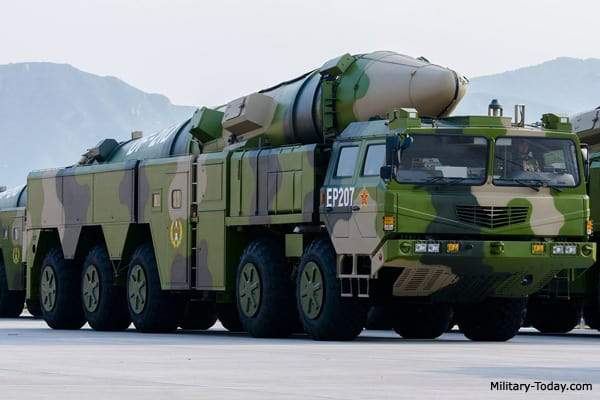China’s Anti-Ship Missile Challenge
Thursday, January 2, 2020
Categories: ASCF News Emerging Threats Missile Defense The Dowd Report

By Alan W. Dowd, ASCF Senior Fellow
JANUARY 2020—Recent reports from the Pentagon and the Congressional Research Service (CRS) paint a worrisome picture of China’s growing anti-ship missile arsenal, the purpose of which is to push the U.S. out of the Western Pacific. What, if anything, can the U.S. do to answer China’s missile challenge?
Taking Aim
Before looking at Washington’s options, let’s spend a moment detailing Beijing’s anti-ship missile (ASM) capabilities.
The Pentagon’s most recent report on China’s military capabilities notes that Beijing is continuing its “militarization in the South China Sea by placing anti-ship cruise missiles and long-range surface-to-air missiles on outposts in the Spratly Islands.”
China’s ASM arsenal includes conventionally armed DF-21D anti-ship ballistic missiles, which have a range of more than 1,500 km and are fitted with a maneuverable reentry vehicle warhead. According to the DoD, the DF-21D gives Beijing “the capability to attack ships, including aircraft carriers, in the western Pacific Ocean.”
China also has developed a long-range, supersonic ASM known as the YJ-12, which is launched from aircraft. China now has a ship-to-ship variant of the YJ-12 (the YJ-12A) and a land-based variant (YJ-12B). “China has deployed the YJ-12B to several outposts in the South China Sea.” DoD adds that China’s growing and diverse arsenal of anti-ship cruise missiles and submarine-launched torpedoes and naval mines “allow the PLAN to create an increasingly lethal, multiaccess threat against an adversary approaching Chinese waters and operating areas.”
In addition to the missiles listed above, CRS notes that Beijing is deploying the DF-26, with a maximum range of about 4,000 kilometers; that China’s first aircraft carrier entered service in 2012; that China’s second aircraft carrier (and first indigenously built carrier) is undergoing sea trials; and that China’s third carrier is under construction. China watchers surmise that Beijing will field as many as six aircraft carriers in the near term. According to CRS, Beijing is fielding these assets to support its “anti-access/area-denial (A2AD) force—a force that can deter U.S. intervention in a conflict in China’s near-seas region…or failing that, delay the arrival or reduce the effectiveness of intervening U.S. forces.”
Beijing added 24 warships to its fleet in 2019, 21 in 2018, 14 in 2017 and 18 in 2016. China now deploys at least 300 warships—more than the 293 deployed by the U.S. Yes, the U.S. still fields the world’s highest-tech Navy—and a battle-tested one at that—but the U.S. Navy is stretched thin as it conducts missions around the world. China’s navy can focus on its neighborhood.
To augment its ASM capabilities, increase its reach and limit freedom of navigation, Beijing has constructed 3,200 acres of illegal islands in international waters—complete with SAM batteries, ASMs and radar systems. One of the islands features a 10,000-foot airstrip—long enough for bombers and fighter-interceptors. All told, Beijing now has 27 military outposts sprinkled across the tiny islands and atolls of the South China Sea, many of them on or encroaching upon waters and territories claimed by other nations.
Add it all up, and China’s A2AD assets pose “a major challenge to the U.S. Navy’s ability to achieve and maintain wartime control of blue-water ocean areas in the Western Pacific—the first such challenge the U.S. Navy has faced since the end of the Cold War,” according to CRS.
The U.S. and its allies have plenty of options to address the threats posed by China’s aggressive A2AD buildup. The question is: Do they have the political will to implement those options?
Reversing A2AD
A2AD tactics can cut both ways, and U.S. military planners are exploring how to make A2AD work against Beijing. Researchers at RAND propose “using ground-based anti-ship missiles as part of a U.S. A2AD strategy” to “challenge Chinese maritime freedom of action should China choose to use force against its island neighbors.”
RAND points out that the U.S. military would not have to supply all the weapons systems or military units needed for such an effort. Instead, the United States could link several strategically located partner nations—Indonesia, Malaysia, Japan, South Korea, Taiwan, the Philippines—in an ASM coalition.
“Indonesia and Malaysia have robust arsenals of medium-range ASMs,” according to RAND, and could put at risk Chinese warships transiting the Strait of Malacca. U.S. ally Singapore sits strategically at the entrance of the strait. ASMs deployed in Taiwan, the Philippines and Japan (Okinawa) “could effectively cover all naval traffic south of Okinawa” as well as the Luzon Strait. ASMs deployed on the southern tip of South Korea and on Japan’s Kyushu island could deny Chinese warships freedom of movement further north.
A mix of land-based Army artillery, rocket systems and air-defense systems, Navy Aegis Ashore batteries, and sea-based Army and Marine precision artillery systems could add punch and flexibility to this ASM coalition; bring a measure of strategic balance into the Indo-Pacific; and remind Beijing that two can play the A2AD game.
This is not just the stuff of think-tank theory.
With an eye on China, Army units have test-fired artillery and rockets from the decks of Navy ships, and Marines have test-fired High Mobility Rocket Systems from amphibious assault ships.
India is building up the Andaman and Nicobar Islands—an archipelago east of the Bay of Bengal—into an outer line of defense. The string of islands will soon be home to military-sustainment ports, dozens of Indian warships, an airbase and squadrons of fighter-interceptors. Australia is eying similar concepts for the Christmas and Keeling Island Territories.Japan is constructing military-grade runways on Mageshima Island, with plans for U.S. and Japanese warplanes to operate from the island base.
We have all the ingredients here of what some call a “Great Wall in reverse” strategy. As James Holmes of the Naval War College explains, “Properly fortified, an archipelagic Great Wall can barricade China within the China seas—and thereby force the PLA to compete on allied terms at a fearsome cost to itself.”
Retooling the Fleet
At the height of President Ronald Reagan’s rebuild, the Navy boasted 594 ships. When President George W. Bush launched the first counterstrokes against al Qaeda, the Navy deployed 316 warships. But today’s fleet numbers less than 300 ships—nowhere near what is needed to deter China and other foes. “For us to meet what combatant commanders request,” according to former Chief of Naval Operations Adm. Jonathan Greenert, “we need a Navy of 450 ships.”
Although Congress codified into law a plan to deploy 355 warships, the Navy is floating proposals to early-retire several ships and slash future shipbuilding plans, in order to reallocate resources to other pressing demands. Defense News calls the proposal “a complete reversal of strategy from the planned 355-ship Navy.”
There are ways to increase America’s maritime strength rapidly. A growing chorus is advocating a “ghost fleet” of heavily-armed, unmanned warships. Unmanned systems are certainly part of the solution, though removing humans from the battlespace presents other dilemmas and problems.
As the Congressional Budget Office (CBO) explains, there also are conventional ways to grow the Navy: delaying retirements of existing ships, reactivating decommissioned ships and building more ships.
According to Navy experts, extending the service life of existing warships from 30 or 40 years to 50 years is eminently doable, as is reactivating mothballed ships. After all, they were mothballed (rather than scuttled) because someone had the good sense that they might be needed someday. And here we are.The CBO points out that the U.S. reactivated 50 destroyers before U.S. entry into World War II, hundreds of ships during the Korean War, the USS New Jersey during the Vietnam War, and the USS Iowa, USS Missouri, USS Wisconsin and USS New Jersey (re-reactivated) during the Reagan rebuild. To be sure, there’s a cost to reactivating warships, but it’s a fraction of the cost of building new ones. More important, a reactivated warship can enter service in a fraction of the time it takes to build a new warship. Jerry Hendrix (a former Navy captain) and Robert O’Brien (a former U.S. diplomat) have identified 11 frigates that could be pulled out of storage and refitted with modern equipment, three mothballed cruisers that could be upgraded with new vertical launch missile systems, and two recently-mothballed amphibious assault ships. Others have urged reactivation of the aircraft carrier USS Kittyhawk.
The Pentagon also could utilize Coast Guard and Army maritime assets to augment missions traditionally conducted by the Navy. In fact, Coast Guard cutters have been deployed to support freedom of navigation ops in the South China Sea. More broadly, there have been proposals in Congress and among military thinkers to shift the Coast Guard to the Department of Defense. This would unify America’s seafaring branches and expand America’s maritime reach.
Regarding the Army’s maritime assets, many Americans are unaware that the Army has a 300-ship navy of its own. A watchword in today’s Pentagon is “jointness”—the notion that all branches must work together across all domains to detect, deter, dissuade and defeat threats. Increased Army-Navy jointness could enable a more dynamic use of the Army’s ocean-going assets, many of which are prepositioned around the world but tethered near land.
Finally, Adm. Mike Mullen promoted the “thousand-ship navy” concept during his tenure as chairman of the Joint Chiefs of Staff. “The United States Navy cannot, by itself, preserve the freedom and security of the entire maritime domain,” he explained. “It must count on assistance from like-minded nations interested in using the sea for lawful purposes…I envision a 1,000-ship navy…made up of the best capabilities of all freedom-loving navies of the world.”
Already, an ad hoc navy of navies—enfolding the combined sea power of the United States and allies in NATO, Japan, Australia, South Korea and India—is promoting maritime security in the East and South China Seas.
Building Up
Building a bigger Navy presupposes more investment in defense. The spending parameters Washington has given the Pentagon have forced the Navy and its sister branches to choose between defending against here-and-now threats and preparing for over-the-horizon threats. Policymakers should give the Pentagon the resources to do both. Put another way, if China wants to start Cold War 2.0, Congress and the White House should shift defense outlays back to Cold War levels.
Today’s defense outlays (as a percentage of GDP and federal spending) are nowhere close to what they were during the Cold War. For most of the Cold War (setting aside the very high levels of defense spending in the early 1950s), Americans spent between 5 and 9 percent of GDP on defense:
In 1953, the United States committed 69 percent of federal outlays and 14 percent of GDP to defense.
In 1968, the United States invested 46 percent of federal spending and 9 percent of GDP in defense.
In 1984, the United States spent 26.7 percent of federal outlays and 5.9 percent of GDP on defense.
Today, the United States invests just 17 percent of federal outlays and 3.33 percent of GDP on defense.
Each of these answers to Beijing’s anti-ship, anti-access gambit—reversing A2AD, knitting together a navy of navies, deploying more ships, increasing defense spending—is achievable and reasonable. But, again, each depends on political will.
Photo: Chinese sources claim that the DF-21D is intended to engage aircraft carriers and other battleships - http://www.military-today.com/missiles/df_21d.htm
















